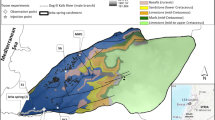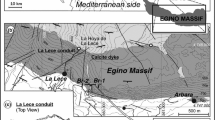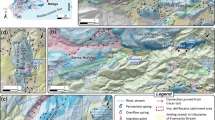Abstract
Methods of modelling non-reactive solute transport based on artificial tracer tests have been widely developed in the past few decades. The dependence of solute transport parameters on boundary conditions has been investigated across different hydrological settings (low and high water level) but still not investigated at the short-term scale (i.e. hourly and daily scale). In this study, a campaign of several tracer tests was performed over a few days to investigate the short-term variations of tracer-test responses in a conduit-dominated karst system (Baget watershed, in the Pyrenees Mountains, France) during a recession without the influence of rainfall. Also, an improved method of interpreting artificial tracer test results, using a process engineering tool, is introduced, consisting of a Laplace-transform transfer function approach with respect to the residence-time distribution curve. Considering the karstic system as a chemical reactor, the introduction of a transfer function approach appears to be an efficient way to describe the solute transport. Moreover, the transfer function is parametrized depending on the spring discharge. The model is extended for testing source pollution scenarios.
Résumé
Les méthodes de modélisation du transport de solutés non réactifs sur la base d’essais de traçage artificiels ont été largement développées ces quelques dernières dizaines d’années. La dépendance des paramètres de transport de solutés aux conditions aux limites a été étudiée pour différentes conditions hydrologiques (basses et hautes eaux) mais pas encore sur de courtes échelles de temps (horaire ou journalière). Dans cette étude, une campagne comprenant plusieurs essais de traçage a été réalisée sur quelques jours pour investiguer les variations à court-terme des réponses des essais de traçage dans un système karstique dominé par des écoulements de conduit (système du Baget, Pyrénées, France) pendant une récession non influencée par la pluie. En outre, une méthode améliorée d’interprétation des résultats d’essais de traçage, utilisant un outil d’ingénierie des procédés, a été introduite. Elle consiste en une approche par une fonction de transfert transformée de Laplace par rapport à la courbe de distribution des temps de séjour. En considérant le système karstique comme un réacteur chimique, l’introduction d’une approche par fonction de transfert apparaît comme un moyen efficace de décrire le transport de solutés. De plus, la fonction de transfert est paramétrée selon le débit de la source. Le modèle est étendu pour tester des scénarios de pollution ponctuelle.
Resumen
En las últimas décadas se han desarrollado ampliamente los métodos de modelado del transporte de soluto no reactivo basado en pruebas de trazabilidad artificial. La dependencia de los parámetros de transporte de los solutos de las condiciones límite ha sido investigada a través de diferentes escenarios hidrológicos (nivel de agua alto y bajo), pero aún no ha sido investigada a una escala de corto plazo (es decir, a escala horaria y diaria). En este estudio, se realizó una campaña de varias pruebas de trazadores durante unos días para investigar las variaciones a corto plazo de las respuestas a dichas pruebas en un sistema kárstico dominado por conductos (cuenca de Baget, en los Pirineos, Francia) durante una recesión sin la influencia de las precipitaciones. Además, se introduce un método mejorado de interpretación de los resultados de las pruebas de trazador artificial, utilizando una herramienta de ingeniería de procesos. Consiste en un enfoque de función de transferencia de transformada de Laplace con respecto a la curva de distribución del tiempo de residencia. Considerando el sistema kárstico como un reactor químico, la introducción de un enfoque de función de transferencia parece ser una forma eficiente de describir el transporte de solutos. Además, la función de transferencia se parametriza en función de la descarga del manantial. El modelo se amplía para probar escenarios de contaminación de la fuente.
摘要
在过去的几十年,基于人工示踪试验的非反应性溶质运移的模拟方法已得到广泛应用。不同水文环境(低水位和高水位)溶质运移参数对边界条件的相关性已经开展过研究,但未开展短期尺度(即每小时和每日尺度)研究。本研究中,几天内开展了多次示踪试验,旨在调查无降雨影响的枯水期以管道为主的岩溶系统(法国Pyrenees山脉的Baget流域)中示踪试验响应的短期变化。此外,还介绍了使用过程工程工具解释人工示踪试验结果的改进方法。该方法包括关于停留时间分布曲线的拉普拉斯变换传递函数方法。考虑到岩溶系统是化学反应器,引入传递函数方法可有效描述溶质的运移。而且传递函数根据泉排泄量进行参数化。该模型可扩展应用于测试源污染方案。
Resumo
Métodos de modelagem de transporte de solutos não reativos baseados em testes de traçadores artificiais têm sido amplamente desenvolvidos nas últimas décadas. A dependência dos parâmetros de transporte de solutos nas condições de contorno tem sido investigada sob diferentes condições hidrológicas (ex. nível de água baixo e alto), entretanto, para escalas de curto prazo (como escala horária e diária) ainda não foi analisada. Neste estudo, uma campanha de vários testes com traçadores foi realizada durante alguns dias, para investigar as variações em curto prazo nas respostas do traçador-teste em um sistema cárstico com canais (bacia hidrográfica Baget, nas montanhas dos Pirineus, França) durante um período com ausência de chuva. Além disso, um método aperfeiçoado para interpretação dos resultados dos testes do traçador artificial, utilizando uma ferramenta de engenharia, foi introduzido. Este método consiste em uma função de transferência obtida por meio da Transformada de Laplace da curva de distribuição do tempo de residência. Considerando o sistema cárstico como um reator químico, o uso da função de transferência se mostrou uma forma eficiente para descrever o transporte do soluto. Além disso, a função de transferência foi parametrizada de acordo com a nascente (descarga do aquífero). O modelo pode ser aplicado para testar a origem de cenários de poluição.










Similar content being viewed by others
References
Ali M, Fiori A, Russo D (2014) A comparison of travel-time based catchment transport models, with application to numerical experiments. J Hydrol 511:605–618. https://doi.org/10.1016/j.jhydrol.2014.02.010
Amin IE, Campana ME (1996) A general lumped parameter model for the interpretation of tracer data and transit time calculation in hydrologic systems. J Hydrol 179(1):1–21. https://doi.org/10.1016/0022-1694(95)02880-3
Becker M, Bellin A (2013) A reservoir model of tracer transport for karstic flow systems. Hydrogeol J 21:1011–1019. https://doi.org/10.1007/s10040-013-0991-2
Birk S, Geyer T, Liedl R, Sauter M (2005) Process-based interpretation of tracer tests in carbonate aquifers. Ground Water 43:381–388. https://doi.org/10.1111/j.1745-6584.2005.0033.x
Bolin B, Rodhe H (1973) A note on the concepts of age distribution and transit time in natural reservoirs. Tellus 25(1):58–62. https://doi.org/10.1111/j.2153-3490.1973.tb01594.x
Bovolin V, Cuomo A, Guida D (2017) Hydraulic modeling of flood pulses in the middle Bussento karst system (MBSKS), UNESCO Cilento global Geopark, southern Italy. Hydrol Process 31:639–653. https://doi.org/10.1002/hyp.11056
Cholet C (2017) Fonctionnement hydrogéologique et processus de transport dans les aquifères karstiques du massif du Jura [Hydrogeological functioning and transport processes in the karstic aquifers of the Jura massif]. PhD Thesis, Université de Bourgogne Franche-Comté, France
Cornaton F, Perrochet P (2006) Groundwater age, life expectancy and transit time distributions in advective–dispersive systems: 1. Generalized reservoir theory. Adv Water Resour 29(9):1267–1291. https://doi.org/10.1016/j.advwatres.2005.10.009
Cvetkovic V (2012) A general memory function for modeling mass transfer in groundwater transport. Water Resour Res 48(4). https://doi.org/10.1029/2011WR011657
De Hoog FR, Knight JH, Stokes AN (1982) An improved method for numerical inversion of Laplace transforms. SIAM J Sci Stat Comput 3:357–366
Debroas E-J (2009) Géologie du bassin versant du Baget (zone Nord-pyrénéenne, Ariège, France): nouvelles observations et conséquences [Geology of the Baget watershed (north-Pyrenean zone, Ariège, France): new observations and consequences]. Strata 2:1–93
Delannoy J-J (1997) Recherches géomorphologiques sur les massifs karstiques du Vercors et de la transversale de Ronda (Andalousie) : les apports morphogéniques du karst [Geomorphological research on the Vercors karst massif and the Ronda transversal (Andalusia): the morphogenic contributions of karst]. PhD Thesis, Université Joseph-Fourier - Grenoble I, France
Dewaide L, Bonniver I, Rochez G, Hallet V (2016) Solute transport in heterogeneous karst systems: dimensioning and estimation of the transport parameters via multi-sampling tracer-tests modelling using the OTIS (one-dimensional transport with inflow and storage) program. J Hydrol 534:567–578. https://doi.org/10.1016/j.jhydrol.2016.01.049
Dewaide L, Collon P, Poulain A, Rochez G, Hallet V (2017) Double-peaked breakthrough curves as a consequence of solute transport through underground lakes: a case study of the Furfooz karst system, Belgium. Hydrogeol J. https://doi.org/10.1007/s10040-017-1671-4
Doerfliger N, Jeannin P-Y, Zwahlen F (1999) Water vulnerability assessment in karst environments: a new method of defining protection areas using a multi-attribute approach and GIS tools (EPIK method). Environ Geol 39:165–176
Doummar J, Margane A, Geyer T, Sauter M (2018) Assessment of key transport parameters in a karst system under different dynamic conditions based on tracer experiments: the Jeita karst system, Lebanon. Hydrogeol J. https://doi.org/10.1007/s10040-018-1754-x
Dreybrodt W (1988) Processes in karst systems: physics, chemistry, and geology. Springer Series in Physical Environment, Springer, Heidelberg, Germany
Duran L, Fournier M, Massei N, Dupont J-P (2015) Use of tracing tests to study the impact of boundary conditions on the transfer function of karstic aquifers. In: Hydrogeological and environmental investigations in karst systems. Springer, Berlin, pp 113–122. https://doi.org/10.1007/978-3-642-17435-3_13
Duran L, Fournier M, Massei N, Dupont J-P (2016) Assessing the nonlinearity of karst response function under variable boundary conditions. Ground Water 54:46–54. https://doi.org/10.1111/gwat.12337
Ender A, Goeppert N, Goldscheider N (2018) Spatial resolution of transport parameters in a subtropical karst conduit system during dry and wet seasons. Hydrogeol J. https://doi.org/10.1007/s10040-018-1746-x
Field MS (2002) The QTRACER2 program for tracer-breakthrough curve analysis for tracer tests in karstic aquifers and other hydrologic systems. National Center for Environmental Assessment, Office of Research and Development, US EPA, Washington, DC
Field MS, Leij FJ (2012) Solute transport in solution conduits exhibiting multi-peaked breakthrough curves. J Hydrol 440–441:26–35. https://doi.org/10.1016/j.jhydrol.2012.03.018
Field MS, Pinsky PF (2000) A two-region nonequilibrium model for solute transport in solution conduits in karstic aquifers. J Contamin Hydrol 44:329–351
Filippini M, Squarzoni G, De Waele J, Fiorucci A, Vigna B, Grillo B, Riva A, Rossetti S, Zini L, Casagrande G, Stumpp C, Gargini A (2018) Differentiated spring behavior under changing hydrological conditions in an alpine karst aquifer. J Hydrol 556:572–584. https://doi.org/10.1016/j.jhydrol.2017.11.040
Ford D, Williams PD (2007) Karst hydrogeology and geomorphology. Wiley, Chichester, UK
Goldscheider N (2004) The concept of groundwater vulnerability. In: Vulnerability and risk mapping for the protection of carbonate (karst) aquifers. Final report (COST Action 620) Report EUR 20912
Goldscheider N (2008) A new quantitative interpretation of the long-tail and plateau-like breakthrough curves from tracer tests in the artesian karst aquifer of Stuttgart, Germany. Hydrogeol J 16:1311–1317. https://doi.org/10.1007/s10040-008-0307-0
Goldscheider N, Hötzl H, Fries W, Jordan P (2001) Validation of a vulnerability map (EPIK) with tracer tests. Presented at the Proc. 7th conference on limestone hydrology and fissured media, Besançon, France, September 2001, pp 167–170
Goldscheider N, Meiman J, Pronk M, Smart C (2008) Tracer tests in karst hydrogeology and speleology. Int J Speleol 37:3
Göppert N, Goldscheider N (2007) Solute and colloid transport in karst conduits under low- and high-flow conditions. Ground Water. https://doi.org/10.1111/j.1745-6584.2007.00373.x
Hauns M, Jeannin P-Y, Atteia O (2001) Dispersion, retardation and scale effect in tracer breakthrough curves in karst conduits. J Hydrol 241:177–193
Hollenbeck KJ (1998) INVLAP.M: a MATLAB function for numerical inversion of Laplace transforms by de Hoog algorithm. https://www.mathworks.com/matlabcentral/answers/uploaded_files/1034/invlap.m. Accessed July 16
Iván V, Mádl-Szőnyi J (2017) State of the art of karst vulnerability assessment: overview, evaluation and outlook. Environ Earth Sci 76. https://doi.org/10.1007/s12665-017-6422-2
Jeannin P-Y (1998) Structure et comportement hydraulique des aquifères karstiques [Structure and hydraulic behaviour of karst aquifers]. PhD Thesis, Université de Neuchâtel, Neuchâtel, France
Jeannin P-Y, Cornaton F, Zwahlen F, Perrochet P (2001) VULK: a tool for intrinsic vulnerability assessment and validation. Presented at the Proc. 7th conference on limestone hydrology and fissured media. Besançon, France, September 2001 pp 185–190
Jury WA, Roth K (1990) Transfer functions and solute movement through soil: theory and applications. Birkhauser, Basel, Switzerland
Käss WA (1994) Hydrological tracing practice on underground contaminations. Environ Geol 23:23–29
Kavouri K, Plagnes V, Dörfliger N, Faycal R, Pierre M (2011) PaPRIKa: a method for estimating karst resource and source vulnerability: application to the Ouysse karst system (Southwest France). Hydrogeol J 19:339–353. https://doi.org/10.1007/s10040-010-0688-8
Kennedy J, Eberhart R (1995) Particle swarm optimization. In: IEEE International Conference on Neural Networks Proceedings of IEEE International Conference on Neural Networks, vol 4. pp 1942–1948. https://doi.org/10.1109/ICNN.1995.488968
Kirchner JW, Feng X, Neal C (2000) Fractal stream chemistry and its implications for contaminant transport in catchments. Nature 403(6769):524–527. https://doi.org/10.1038/35000537
Kovács A, Perrochet P (2008) A quantitative approach to spring hydrograph decomposition. J Hydrol 352:16–29. https://doi.org/10.1016/j.jhydrol.2007.12.009
Labat D, Mangin A (2015) Transfer function approach for artificial tracer test interpretation in karstic systems. J Hydrol 529:866–871. https://doi.org/10.1016/j.jhydrol.2015.09.011
Lauber U, Ufrecht W, Goldscheider N (2014) Spatially resolved information on karst conduit flow from in-cave dye tracing. Hydrol Earth Syst Sci 18:435–445. https://doi.org/10.5194/hess-18-435-2014
Leclerc JP, Claudel S, Lintz HG, Potier O, Antoine B (2000) Theoretical interpretation of residence-time distribution measurements in industrial processes. Oil Gas Sci Technol 55(2):159–169
Leibundgut C (1998) Vulnerability of karst aquifers. IAHS Publ. 247, IAHS, Wallingford, UK, pp 45–60
Levenspiel O (1999) Chemical reaction engineering, 3rd edn. Wiley, Hoboken, NJ
Levenspiel O (2012) Tracer technology, fluid mechanics and its applications. Springer, New York. https://doi.org/10.1007/978-1-4419-8074-8
Luhmann AJ, Covington MD, Alexander SC, Chai SY, Schwartz BF, Groten JT, Alexander EC Jr (2012) Comparing conservative and nonconservative tracers in karst and using them to estimate flow path geometry. J Hydrol 448–449:201–211. https://doi.org/10.1016/j.jhydrol.2012.04.044
Małoszewski P, Zuber A (1982) Determining the turnover time of groundwater systems with the aid of environmental tracers: 1. Models and their applicability. J Hydrol 57(3):207–231. https://doi.org/10.1016/0022-1694(82)90147-0
Mangin A (1975) Contribution à l’étude hydrodynamique des aquifères karstiques [Contribution to the hydrodynamic study of karst aquifers]. Université de Bourgogne, France
Mangin A (1984) Pour une meilleure connaissance des systèmes hydrologiques à partir des analyses corrélatoire et spectrale [The use of autocorrelation and spectral analyses to obtain a better understanding of hydrological systems]. J Hydrol 67:25–43. https://doi.org/10.1016/0022-1694(84)90230-0
Mangin A (1994) Karst Hydrogeology. In: Danielopol DL, Stanford JA (eds) Groundwater ecology. Academic, San Diego, CA, pp 43–67
Marín AI, Andreo B, Mudarra M (2015) Vulnerability mapping and protection zoning of karst springs: validation by multitracer tests. Sci Total Environ 532:435–446. https://doi.org/10.1016/j.scitotenv.2015.05.029
Marsaud B (1997) Structure et fonctionnement de la zone noyée des karsts à partir des résultats expérimentaux [Structure and behaviour of the saturated zone of karst aquifers from experiential results]. Université de Paris XI Orsay, Paris
Massei N, Wang HQ, Field MS, Dupont JP, Bakalowicz M, Rodet J (2006) Interpreting tracer breakthrough tailing in a conduit-dominated karstic aquifer. Hydrogeol J 14:849–858. https://doi.org/10.1007/s10040-005-0010-3
Massoudieh A (2013) Inference of long-term groundwater flow transience using environmental tracers: A theoretical approach. Water Resour Res 49(12):8039–8052. https://doi.org/10.1002/2013WR014548
Matsubayashi U, Velasquez GT, Takagi F (1993) Hydrograph separation and flow analysis by specific electrical conductance of water. J Hydrol 152:179–199
Milanović P (2014) Hydraulic properties of karst groundwater and its impacts on large structures. In: Mudry J, Zwahlen F, Bertrand C, LaMoreaux JW (eds) H2Karst research in limestone hydrogeology. Springer, Cham, Switzerland, pp 19–48. https://doi.org/10.1007/978-3-319-06139-9_2
Morales T, Uriarte JA, Olazar M, Antigüedad I, Angulo B (2010) Solute transport modelling in karst conduits with slow zones during different hydrologic conditions. J Hydrol 390:182–189. https://doi.org/10.1016/j.jhydrol.2010.06.041
Moser H (1995) Groundwater tracing. In: Tracer technologies for hydrological systems. Presented at the Proceedings of a Boulder Symposium, IAHS, Wallingford, UK
Nash JE (1957) The form of the instantaneous unit hydrograph. IAHS Publ. 3, IAHS, Wallingford, UK, pp 114–121
Niemi AJ (1977) Residence time distributions of variable flow processes. Int J Appl Radiat Isot 28(10):855–860. https://doi.org/10.1016/0020-708X(77)90026-6
Ozyurt NN, Bayari CS (2005) Steady- and unsteady-state lumped parameter modelling of tritium and chlorofluorocarbons transport: hypothetical analyses and application to an alpine karst aquifer. Hydrol Process 19(17):3269–3284. https://doi.org/10.1002/hyp.5969
Padilla A, Pulido-Bosch A (1995) Study of hydrographs of karstic aquifers by means of correlation and cross-spectral analysis. J Hydrol 168:73–89
Perrin J, Pochon A, Jeannin P-Y, Zwahlen F (2004) Vulnerability assessment in karstic areas: validation by field experiments. Environ Geol 46. https://doi.org/10.1007/s00254-004-0986-3
Quinif Y (1999) Karst et évolution des rivières: le cas de l’Ardenne [Karst and river evolution: the Ardenne case]. Geodin Acta 12:267–277
Ravbar N, Goldscheider N (2009) Comparative application of four methods of groundwater vulnerability mapping in a Slovene karst catchment. Hydrogeol J 17(3):725–733. https://doi.org/10.1007/s10040-008-0368-0
Schnegg P-A (2002) An fextensive field fluorometer for hydrogeological tracer tests with three tracers and turbidity measurement. In: Bocanegra E, Martinez D, Massone H (eds) Groundwater and human development. Presented at the XXXII IAH and ALHSUD Congress. Mar del Plata, Argentina, 2002, Balkema, Rotterdam, The Netherlands, pp 1484–1488
Sivelle V, Labat D, Duran L, Massei N, Fournier M (2018) Artificial tracer tests interpretation using transfer function approach to study the Norville Karst system. In: Bertrand C, Renard P, Denimal S, Steinmann M (eds) Advances in the hydrogeology of karst and carbonate reservoirs, chap 22. Eurokarst 2018, Besançon, France
Toride N, Leu FJ, Van Genuchten MT (1993) A comprehensive set of analytical solutions for nonequilibrium solute transport with first-order decay and zero-order production. Water Resour Res 29:2167–2182
Toride N, Leij FJ, Van Genuchten MT et al (1995) The CXTFIT code for estimating transport parameters from laboratory or field tracer experiments. US Salinity Laboratory, Riverside, CA
Van Genuchten MT, Simunek J, Leij FJ, Toride N, Sejna M (2012) STANMOD: model use, calibration, and validation. Trans ASABE 55:1353–1366
Vincenzi V, Riva A, Rossetti S (2011) Towards a better knowledge of Cansiglio karst system (Italy): results of the first successful groundwater tracer test. Acta Carsol 40(1)
Walas SM (2005) Chemical reaction engineering handbook of solved problems. Gordon and Breach, Australia
Wang HQ, Crampon N, Huberson S, Garnier JM (1987) A linear graphical method for determining hydrodispersive characteristics in tracer experiments with instantaneous injection. J Hydrol 95:143–154. https://doi.org/10.1016/0022-1694(87)90121-1
Worthington SR (2003) A comprehensive strategy for understanding flow in carbonate aquifer. Speleogenesis Evol Karst Aquifers 1:1–8
Worthington SRH, Ford DC (2009) Self-organized permeability in carbonate aquifers. Ground Water 47:326–336. https://doi.org/10.1111/j.1745-6584.2009.00551.x
Zhao X, Chang Y, Wu J, Peng F (2017) Laboratory investigation and simulation of breakthrough curves in karst conduits with pools. Hydrogeol J 25:2235–2250. https://doi.org/10.1007/s10040-017-1626-9
Acknowledgements
The authors would like to thank the KARST observatory network (SNO KARST) initiative at the INSU/CNRS, which aims to strengthen knowledge sharing and promote cross-disciplinary research on karst systems at the national scale. We also thank “Météo-France” for providing rainfall data and BRGM (French Geological Survey) for providing discharge data.
Funding
This work has been funded by “l’Agence de l’eau Adour Garonne”.
Author information
Authors and Affiliations
Corresponding author
Rights and permissions
About this article
Cite this article
Sivelle, V., Labat, D. Short-term variations in tracer-test responses in a highly karstified watershed. Hydrogeol J 27, 2061–2075 (2019). https://doi.org/10.1007/s10040-019-01968-3
Received:
Accepted:
Published:
Issue Date:
DOI: https://doi.org/10.1007/s10040-019-01968-3




